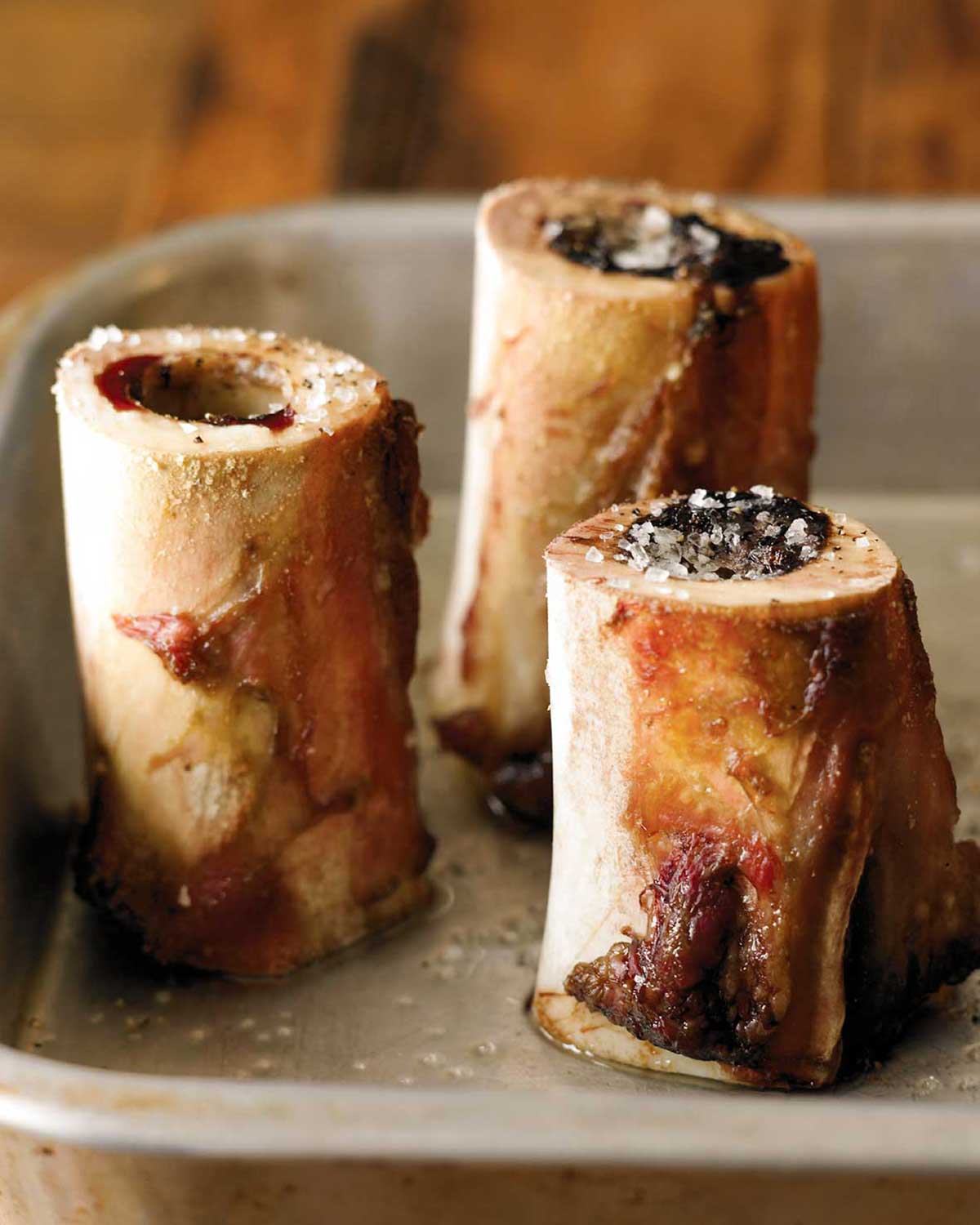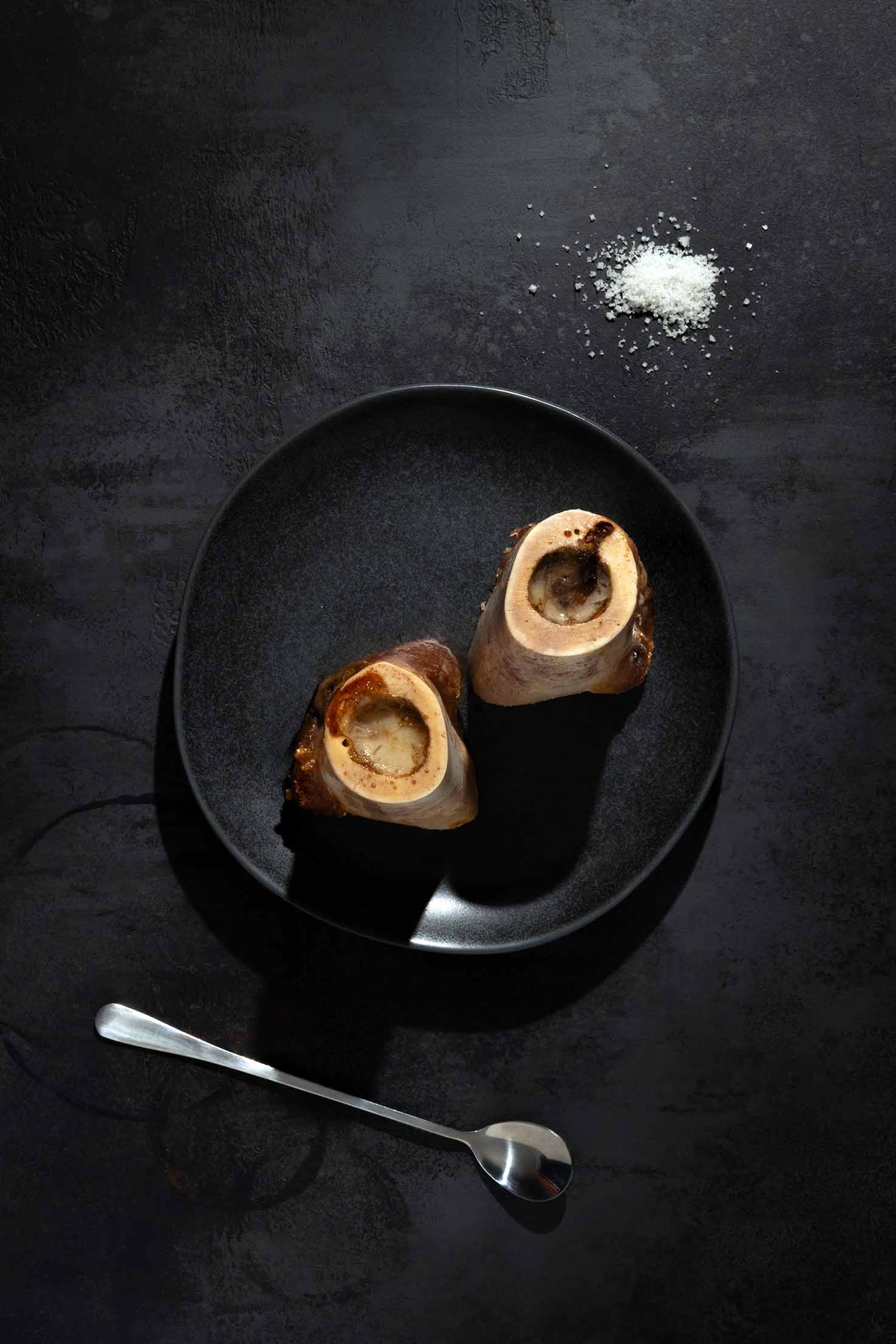
Jennifer McLagan says, “I find it encouraging to know that this odd bit, once consigned to the soup pot, tossed to the dog, or thrown in the garbage, is now finally being appreciated as a dish in its own right. Now that good fat is back on the table, marrow is seemingly everywhere.
“Many people avoid roasted bone marrow because it’s fat. But it should be remembered that marrow is 69 percent unsaturated fat. It’s also a very nutritious food, containing iron, phosphorus, vitamin A, and trace amounts of thiamin and niacin.
“There’s even more good news for marrow lovers. Science has shown that the fat of ruminants contains substances that boost and maintain our body’s immune system. So the Victorians were right—it is a healthy food and definitely way too good for the dog.”

Why Our Testers Loved This
The testers are describing this roasted marrow as “impressive,” “rich,” and “decadent.” Tester Anna Scott was delighted that this classic appetizer used “simple ingredients and methods with outrageously delicious results.”
Notes on Ingredients

- Beef marrow bones–These generally come from the femur (upper leg bone) of the cow and are ideal for cutting lengthwise, called a canoe cut, but you can also find smaller bones cut crosswise, which will work just as well. The cut bones should already be free of meat and should smell clean and faintly meaty. If there’s meat on the bones, like mine above, you can remove it before or after soaking.
- The marrow itself should be whitish-pink in color; don’t worry if you can see blood spots on the surface—that’s normal.
- Sea salt–This is used in the soaking water to help draw out any impurities in the marrow. You’ll need to use 1 teaspoon of coarse salt for each cup of water and replace the solution every 4 hours.
How to Roast Bone Marrow

- Add the marrow bones to a large bowl and fill it with ice water, making sure they’re submerged. Add 1 teaspoon of salt for each cup of water in the bowl. Refrigerate for 12 to 24 hours, replacing the salt water solution every 4 hours.
- Drain the bones, cover them, and chill until you’re ready to roast them. Preheat the oven to 450°F. Place the bones, cut side up, in a roasting pan or on a sturdy baking sheet.
- Roast until the marrow is puffed and has reached an internal temperature of 145°F (63°C). Sprinkle with sea salt and serve immediately.
Common Questions
According to dietitian Rachael Ajmera on Healthline, marrow has a very high collagen content, which improves joint and skin health and reduces inflammation.
I recommend it. Soaking the bones draws out any remaining blood or impurities. It’s cosmetic, and there isn’t any harm in cooking the marrow without soaking, but it makes for a prettier presentation, and you won’t find any clumps of coagulated blood while you’re enjoying your meal.
Yes. I recommend defrosting the bone marrow in the refrigerator before cooking. You can cook it directly from frozen, but the roasting time will increase.
Pro Tips
- Marrow bones can be cut to any length you want. Ask your local butcher for pieces cut from the center of the leg bone, where the ratio of marrow to bone is highest. It’s tricky to judge how much marrow you’ll get from any bone as it ranges widely depending on the thickness of the bone: A 3-inch (7.5-centimeter) bone usually averages around 1 1/2 ounces (40 grams).
- Buy extra bones to be sure you have enough. Bone marrow freezes well in or out of the bone.
- You can ask for the bones to be cut lengthwise, called canoe cut. This makes the marrow easy to get at with any spoon—no need for a fancy lomg-handle spoon.
Storage & Reheating Instructions
Once soaked, bone marrow should be refrigerated and cooked within 24 hours or frozen for up to 3 months. To freeze bone marrow, wrap the soaked bones in plastic, then store them in a resealable bag or airtight container.
After cooking, roasted bone marrow can be refrigerated for up to 2 days or frozen for up to 3 months. Reheat in a 300°F (150°C) oven until warmed through. Do keep an eye on it, as it will begin to melt if overheated.
Leftover cooked bone marrow can also be mixed into butter to create an excellent compound butter topping for grilled beef tenderloin.
What to Serve with This Recipe
If you’re serving these as a first course or appetizer, simply sprinkle with a bit of salt and pepper, garnish with some fresh herbs or microgreens, and serve with some toasted bread rounds.
If you want to make this a main course, offer it alongside a fresh salad dressed with lemon vinaigrette or some vegetables, such as asparagus or broccoli roasted with olive oil, salt, and pepper.

Write a Review
If you make this recipe, or any dish on LC, consider leaving a review, a star rating, and your best photo in the comments below. I love hearing from you.–David
I loved this beef bone marrow recipe! I have been so anxious about making it, but it was super easy! I did just as the recipe instructed, and it turned out beautifully!
Denise

Roasted Bone Marrow
Ingredients
- Four (3-inch) marrow bones
- Coarse sea salt
- Freshly ground pepper
Instructions
- Fill a large bowl halfway with ice water and add 1 teaspoon of coarse sea salt per 1 cup water. Add the marrow bones and refrigerate for 12 to 24 hours, changing the water every 4 hours and replacing the salt each time.
☞ TESTER TIP: Some testers have asked us, "Do I need to soak the bones?" The answer is yes. This removes the blood and any impurities from the marrow.
- Drain the bones, cover, and refrigerate until you're ready to roast the marrow. Be sure to roast the soaked marrow within 24 hours or freeze the drained bones for up to 3 months.
- Crank the oven to 450°F (230°C).
- Place the marrow bones in a roasting pan. If the bones are cut crosswise, place them standing up; if the bones are cut lengthwise, place them cut side up.
- Roast for 15 to 25 minutes, until the marrow has puffed slightly and has an internal temperature of 145°F (63°C) in the center when measured with an instant-read thermometer. If you don't have a thermometer, insert a metal skewer into the center of the bone, then touch it to your wrist to gauge the marrow’s temperature; the roasted bone marrow should be very hot. Do take care not to burn yourself. There should be no resistance when the skewer is inserted, and some of the marrow will have started to leak from the bones.
- Sprinkle with sea salt and pepper. Serve immediately with spoons for scooping.

Nutrition
Nutrition information is automatically calculated, so should only be used as an approximation.
Recipe Testers’ Reviews
What an elegant treat this roasted bone marrow was! This dish is the epitome of classic French cooking to me—simple ingredients and methods with outrageously delicious results. And oh so impressive!
Served alongside a warm baguette, this appetizer was a real winner. Rich, creamy bone marrow spread on a piece of crusty bread—you can’t get much more decadent than that. It’s nature’s equivalent of butter on bread.
I sprinkled the tops of the marrow bones with kosher salt right when they came out of the oven for a little added flavor. A fancy, coarse sea salt would work well, too. I cooked my bones at 450°F for 30 minutes and the marrow came out perfectly.
I was incredibly excited to have the opportunity to make this recipe to ring in the New Year, especially since I’ve had this dish in several French bistro-style restaurants but never at home, as New Year’s to me is all about decadent food that’s comforting at the same time. My grocery store always seems to carry bone marrow, so believe me when I say that one of my New Year’s resolutions is to treat myself to this culinary delight many more times this year!
Although I personally thought the recipe was too long-winded—I’ve made roasted marrow before without the soaking—it turned out perfectly, and we thoroughly enjoyed eating it.


















I grew up with bone marrow appetizers. Found 10” long marrow bones in the frozen dog bone section at this butcher. They have some 2” wide marrow openings!! He halved the bones for me but I should have asked to cut them lengthwise. It took 45min in the oven and even then some of the marrow needed to be fried to cook it through. In the end the dish was as delicious as I remember from my childhood.
Thanks, Katharina. I’m so glad you enjoyed this and that it brought back those special memories.
I picked up some bone marrow for the first time and noted the recipe instructions to change the water every 4 hours for 24 hours. Do you actually get up through the night to change the water? Thank you.
That would be the ideal scenario, Buck, although not a particularly enjoyable one. It’s ok to soak the marrow for just 12 hours, so you could just start the soaking process very early in the day. If soaking overnight, I think it would be ok to stretch the soaking for a few extra hours if you change the water just before going to sleep and again as soon as you are up.
I did but I am a bit OCD. 🙂
Nothing wrong with that, Steve!
Thank you so much for your quick and informative reply. That’s along the lines of what I expected I’d wind up doing anyway. My bones are soaking in cold water now, both the marrow and the body. It’s pouring cold rain here in Seattle?
Do let us know how it turns out, Buck! And stay warm . . .
I prepped and cooked per the recipe. When I popped it out of the oven I thought “Well here goes”. As I scooped out the marrow I admit to being a bit surprised it was almost a liquid slurry. I wasn’t sure what to expect. That being said, I smeared it on a piece of whole wheat toast (since that’s what I had at hand). It was delicious!! My wife was hesitant to try it, but took a small bite, looked a bit surprised and said “that’s pretty good”. I am giving the Carnivore Code eating plan a try and the author points out the nutritional value and historic preference of our ancestors for consuming marrow. So my initial objective was for the nutritional content, but now I’ve decided, despite the work involved in the extended soaking prep, I will make it again simply for the subtle and delicious flavors. The sea salt also really contributed to the experience. Thanks again for your recipe and your helpful follow-up advice.
I’m so pleased to hear this, Buck! Thanks so much for taking the time to let us know.
Can you eat them as a meal? And if so, what would you serve with them?
Yes, Melinda, you absolutely can eat them as a meal, or as an appetizer, or as part of a tapas-style meal. There aren’t really any rules, however, bone marrow is quite rich so you might want to pair it with something bright and fresh, like a salad, or with some roasted vegetables. It’s nice to serve the bone marrow with some toasts and salt for sprinkling over. Really, the sky is the limit.